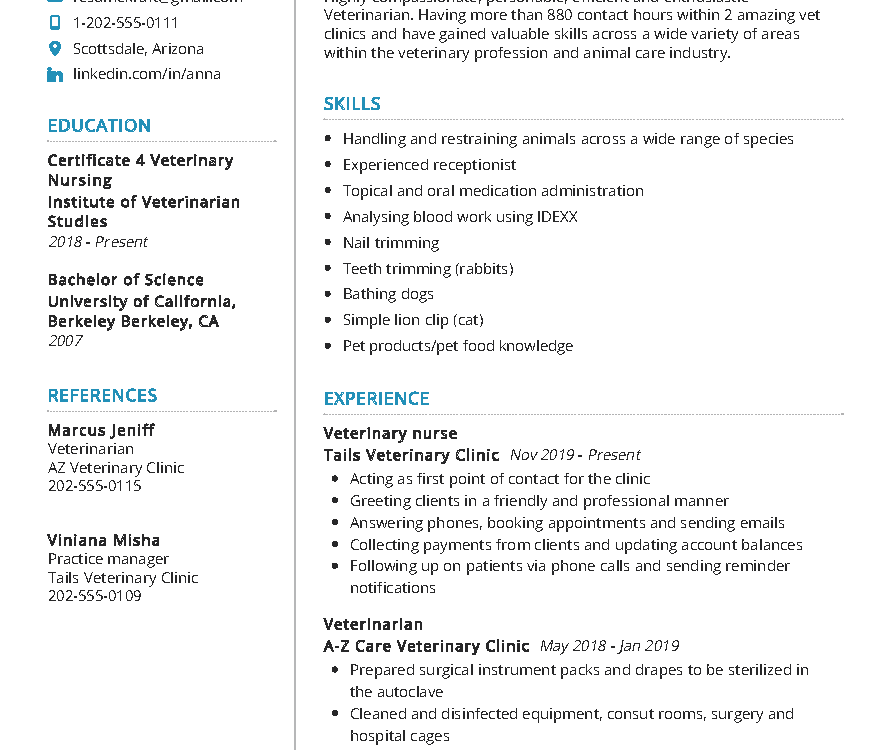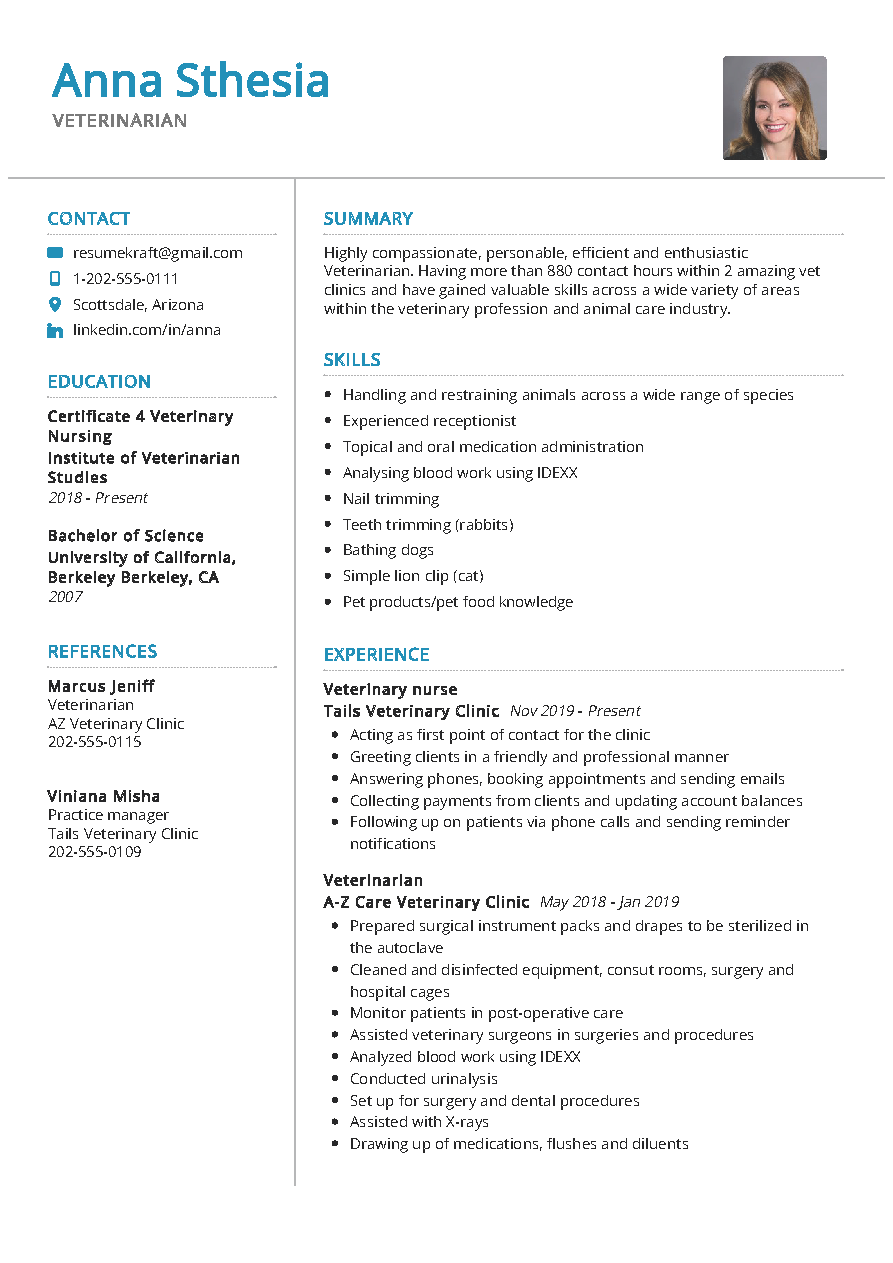Veterinarian Resume Example
Anna Sthesia
VETERINARIAN
CONTACT
resumekraft@gmail.com
1-202-555-0111
Scottsdale, Arizona
linkedin.com/in/anna
SUMMARY
Highly compassionate, personable, efficient and enthusiastic Veterinarian. Having more than 880 contact hours within 2 amazing vet clinics and have gained valuable skills across a wide variety of areas within the veterinary profession and animal care industry.
SKILLS
- Handling and restraining animals across a wide range of species Experienced receptionist
- Topical and oral medication administration Analysing blood work using IDEXX
- Nail trimming
- Teeth trimming (rabbits) Bathing dogs
- Simple lion clip (cat)
- Pet products/pet food knowledge
EDUCATION
Certificate 4 Veterinary Nursing
Institute of Veterinarian Studies 2018 – Present
Bachelor of Science – University of California,
Berkeley Berkeley, CA 2007
EXPERIENCE
Veterinary nurse
Tails Veterinary Clinic Nov 2019 – Present
- Acting as the first point of contact for the clinic
- Greeting clients in a friendly and professional manner
- Answering phones, booking appointments and sending emails
- Collecting payments from clients and updating account balances
- Following up on patients via phone calls and sending reminder notifications
Veterinarian
A-Z Care Veterinary Clinic May 2018 – Jan 2019
- Prepared surgical instrument packs and drapes to be sterilized in the autoclave
- Cleaned and disinfected equipment, consult rooms, surgery, and hospital cages
- Monitor patients in post-operative care
- Assisted veterinary surgeons in surgeries and procedures Analyzed blood work using IDEXX
- Conducted urinalysis
- Set up for surgery and dental procedures Assisted with X-rays
- Drawing up of medications, flushes, and diluents
REFERENCES
Marcus Jeniff
Veterinarian
AZ Veterinary Clinic 202-555-0115
Viniana Misha Practice manager Tails Veterinary Clinic 202-555-0109
Veterinarian Resume with Writing Guide
It’s not easy finding a full-time job as a veterinarian, which is why it’s important to make your resume stand out. Join our blog and get all the tips and tricks you need for writing that perfect resume.
A lot of people shy away from writing traditional resumes because they don’t know where to start or what content is essential. With this guide, you’ll have everything you need to help create an outstanding resume that will be noticed by recruiters and land you the interview call.
Veterinarian Resume Writing Guide:
Whether you’re a new graduate, graduating from vet school or considering a job in sales, you’ll be able to create a resume that highlights your key skills. Learn how to tailor your resume to the industry you’re in and make it shine with this guide for creating the perfect Veterinarian Resume.
Summarise Your Education and Skills
There’s quite a bit of information about your education and experience on your resume, but it’s vital that you do not overload your resume with large amounts of text. Instead, you want to focus on summarising these sections if they’re required.
If you have a degree or diploma, highlight the key skills you learned in your education and include your grades from undergraduate school and any postgraduate schools. If you don’t have an advanced degree, include the most crucial skills acquired from your training. In either case, make sure to put the most important skills first.
Work Experience
In the work experience section, you’ll want to make sure you have all of your prior work experience, internships, and any other relevant work history. Include any volunteer work or even accolades you received at work. If you’re still in training, omit your current position.
While it may seem harsh to omit your current job from the resume until after an interview is scheduled, it’s better to leave it out on your resume and include a cover letter stating this request. If you don’t include a cover letter stating your request for recognition, you’ll likely be removed from the short list of potential candidates and your application will be trashed.
Put Your Education and Work Experience First
It may seem like common sense but it’s incredibly important to put your most current education and work experience first. With recruiters being short on time, you want to make sure they spend as little time as possible finding this section.
This is also important for the resume structure. If you have a section dedicated to education first, make sure to put your education after all of your work experience and include any awards. This is because recruiters are typically interested in the skills you acquired rather than the company and position you are in.
Awards & Accolades
Awards are a great way to showcase your accomplishments and highlight key skills which will be useful on the job.
Veterinarian Responsibilities:
- Perform/Assist with the evaluation of all surgical and nonsurgical treatments.
- Maintain records, perform species identification and assist in diagnosis.
- Provide first aid to injured animals
- Perform radiology procedures, if necessary, including x-ray and ultrasound imaging
- Assist in other appropriate activities as needed
- Assist in surgery and other procedures as applicable
- Assist in the development of clinical protocols
- Assist with research activities as necessary.
- Perform or assist in the collection of laboratory procedures
- Assist in maintaining records from basic to complex with clear and concise reporting methods.
- Periodically review and evaluate programs to ensure appropriate/efficient use of resources and manpower
- Establish and maintain working relationships with fellow employees
- Adhere to all University, Government and commercial regulations, rules, and directives
- Assist in meeting mandated health and safety requirements as applicable
- Participate in assessing the needs of the department, college, or university(s) and help provide direction to revise and enhance current programs and plans.
- Demonstrate competence with respect to the field of Veterinary Medicine by upholding high standards of ethical conduct in all professional activities within the scope of practice
Top 10 Must-have Veterinarian Skills:
- Knowledge of operations and practices in a veterinary clinical setting
- Knowledge of animal anatomy and physiology
- Knowledge of medicine, including chemicals, instruments, and devices used in treatment
- Knowledge of the surgical procedures and techniques used by veterinarians
- Skill in handling animals
- Skill in handling instruments and equipment used to diagnose, treat, or care for animals
- Skill in performing laboratory tests on blood, tissue samples, or other bodily fluids to draw conclusions regarding the condition of animals
- Skill in communicating with patients and clients
- Knowledge of the impact emotionally on the well-being of animals as humans, and providing compassionate care to them
- Skill in delivering pre- or post-surgical care to animals in a humane manner as well as diagnosing conditions
- Skill in caring for sick or injured animals, including general surgical procedures and handling minor surgical emergencies
- Knowledge of animal behavior
- Reasoning skills, including observation, reading, and math computation
- Systematizing and prioritizing
- Organizing ideas and expressing thoughts in writing
- Interpersonal skills in communicating with patients, clients, owners, and staff
- Organizational skills, including prioritization
- Time management and scheduling flexibility to meet deadlines in a veterinary clinical setting or in operating clinical laboratories at a clinic or hospital setting
Tips to write a Veterinarian Resume Summary:
A veterinarian resume summary is a summary statement that shows all strengths and skills. This is a short summary of your skills and experience.
Veterinarian resumes and cover letters should always start with an objective. The objective of any job application is to make the hiring manager see what kind of person you are, what you can do, and how you will fit in with that company’s needs.
Tips:
- Be as detailed as possible: The more specific you are the better. If you have experience in a topic, be very specific about that, how much and what kind of experience.
- Use numbers to show how long you have been doing a job or skills you have acquired: If you want to show that you had experience in a certain area, then start with the numbers and show the years of time spent. For example “I worked for 3 years at one company as a Veterinarian assistant before I moved on.”
- Use numbers to show that you are experienced and good at certain things: For example “I have 4 years of experience in large animal
veterinary medicine, 5 years of experience in small animal veterinary care and 12 years of hands on experience working with cats” - Talk about what you can do: Do your best to get the hiring manager excited to meet you, so talk about what you can do for the company. Include interesting facts about yourself.
How to write a Veterinarian Resume with No experience:
- State the usual courses of study that you have followed/taught for educational background or previous work experience.
- List skills and experiences you apply towards a veterinary career. Be sure to mention your level of expertise and training in each area so they can recognize your qualifications quickly.
- Explain how your personal talents help you succeed in the field of veterinary medicine.
- Sum up what you want to communicate about yourself (why should an employer hire you) in a one paragraph summary about yourself or your career path.
- List interests, hobbies and any other achievements you have made.
- Choose the most appropriate contact information for employers (address, phone number, email).
- If possible, review your resume with someone who has experience in what you do before you send it out to potential employers.
How to write a Veterinarian Cover Letter:
A Veterinarian cover letter should be short and to the point. Follow these expert tips on how to write a Veterinary cover letter that will catch your employer’s attention. When writing a Vet cover letter, it is important to let the employer know how you can benefit the company. You should highlight your relevant skills, experience and qualifications in the Veterinary cover letter resume.
A well-written Veterinary cover letter will help give you an advantage over other applicants for the job. It is important to include as much relevant information as possible and highlight why you are ideal for this particular position.
Tips:
- Yes, your cover letter needs to be short. A classic rule of thumb called the “Rule of 2” applies here (2-6 sentences for a cover letter) and it helps keep the focus on the most important points. Compare your cover letter to a newspaper article: It will be interesting, succinct, full of information and concise. It should not be longer than a newspaper article and should never take more than two minutes to read.
- Your cover letter should be easy to read, clear and straight to the point. You must use a simple format with an easily recognizable layout in order for your cover letter to be successful.
- Always keep the receiver at the top right-hand corner of your cover letter
- Use the same wise: Just like newspaper columns keep an aspect ratio of 8:3, so should your margins. The top margin should be just big enough to include your name and address (with room for a stamp).
Key Takeaways:
- Use this guide as a starting point for crafting your resume that showcases your soft skills and the skills you gained while in school.
- A job seeker can customize his resume to help his resume stand out.
- A custom resume is a competitive advantage and helps you land your dream job.
- This resource will show you how to customize a resume for your profession.


